If mushrooms tickle your fancy, you may feel tempted to search for some wild ones and cook them in your kitchen. However, this can be hazardous, as certain mushrooms can be fatally poisonous and easily confused with safe varieties. The death cap mushroom is among the most well-known examples of this, causing the majority of lethal mushroom poisonings globally. Notably, when young this mushroom bears a striking resemblance to some edible puffball mushrooms, which makes it all the more problematic. In this article, we’ll examine crucial differences between death cap mushrooms vs. puffball mushrooms to help you avoid a potentially deadly blunder.
Death Cap Mushrooms (Amanita phalloides)
Death cap mushrooms are poisonous fungi belonging to the genus Amanita and the family Amanitaceae, which includes other toxic mushrooms such as fly agaric and destroying angel. These mushrooms are indigenous to Europe and form symbiotic relationships with different types of broadleaved trees.
However, they’ve also been inadvertently introduced to other regions, including North America, Australia, and Asia, through the roots of imported oak, chestnut, pine, and other non-native trees.
The death cap mushroom is responsible for many fatal mushroom poisonings globally. These fungi harbor a variety of toxins that can severely damage the liver and kidneys, leading to a range of symptoms such as:
- Nausea
- Vomiting
- Diarrhea
- Abdominal pain
- Jaundice
- Seizures
- Coma
The onset of symptoms usually occurs 6 to 12 hours after ingestion and may improve temporarily before becoming worse. If enough is eaten, death can happen within a few days, making it a race against time to seek treatment. Luckily, there are some specific treatments that show promise, hospitalization is still necessary, and severe case can require a liver transplantation.
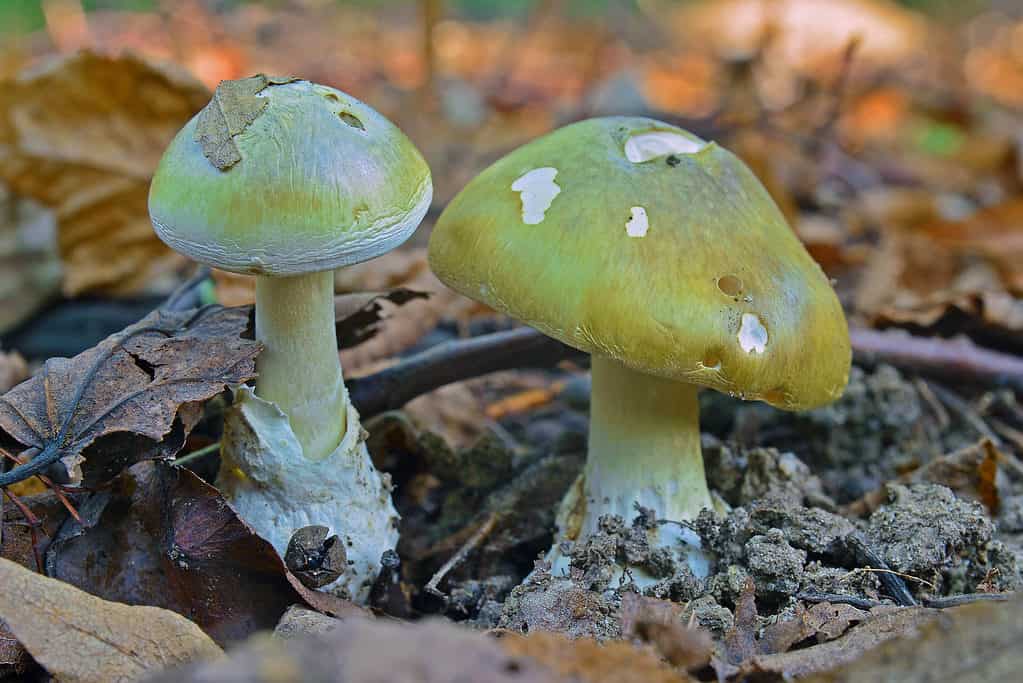
The death cap mushrooms can cause severe liver and kidney damage.
©iStock.com/empire331
Puffball Mushrooms
Puffball mushrooms are a group of fungi that produce spherical or globular fruiting bodies that release spores when they mature. They belong to the family Agaricaceae, which also includes common button mushrooms and portobellos.
Some puffballs have a scientific name that reflects their shape: Lycoperdon, which means “wolf fart” in Greek. Different cultures and civilizations have used puffballs for food, medicine, art, and entertainment.
There are several species of puffball mushrooms, but they all share some common characteristics. Let’s discover some of the most common puffball species.
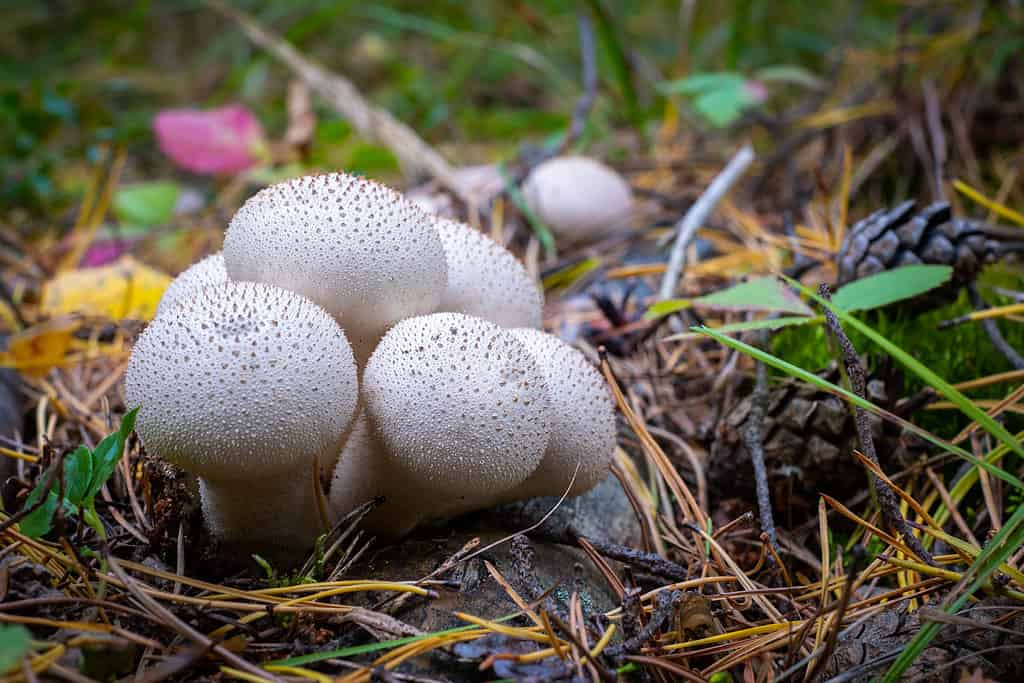
The puffball mushrooms have a variety of purposes, such as being used for food, art, medicine, and more.
©Andrei Ksenzhuk/Shutterstock.com
1. Lycoperdon perlatum
Lycoperdon perlatum is also known as the “gem-studded puffball”. It’s a mushroom species Christian Hendrik Persoon described in 1796. This intriguing fungus goes by several other names, such as “common puffball,” “warted puffball,” “wolf farts,” or “devil’s snuff-box.”
A notable characteristic of this species is the cone-shaped spiny bumps that cover its surface. These spines leave pock-mark scars when they fall off, which distinguishes Lycoperdon perlatum from similar-looking puffball types that may have different surface textures or spines that don’t leave scars. It grows in grasslands, woodlands, and gardens.
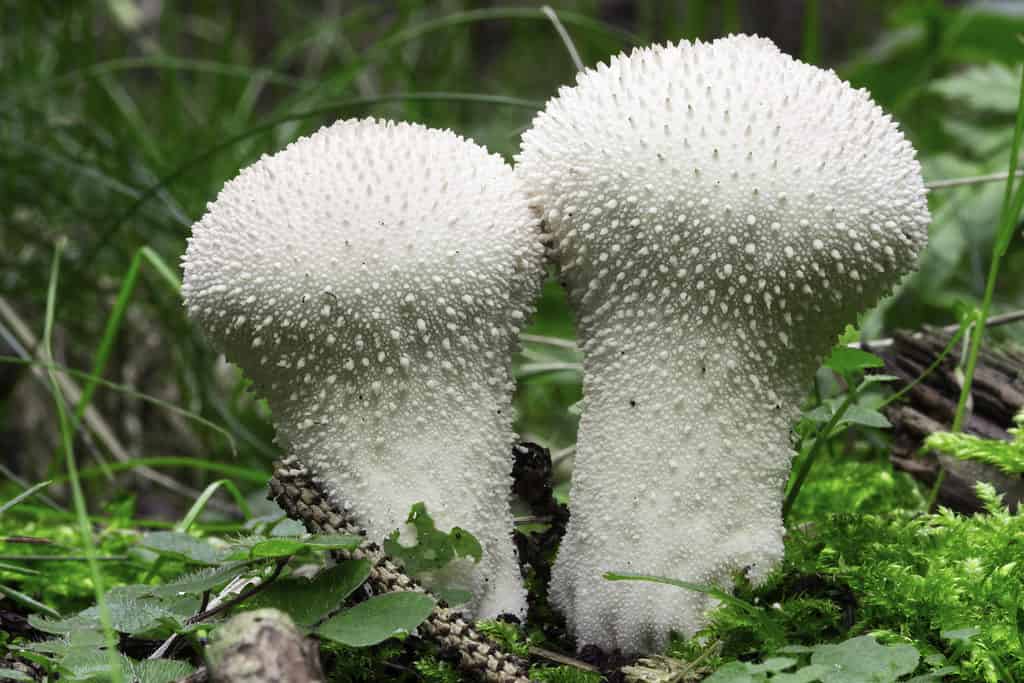
The spikes on the
Lycoperdon perlatumleave pock-mark scars when they fall off.
©gstalker/Shutterstock.com
2. Lycoperdon pyriforme
Apioperdon pyriforme is a notable species of fungi that flourish on decaying wood. It’s also known as a “pear-shaped puffball” or “stump puffball.” Its fruiting bodies appear in dense clusters during the autumn season, varying in size from 2 to 4.5 cm in height and 1.5 to 4.5 cm in width, typically exhibiting a pear-shaped or spherical form.
An extraordinary characteristic of this species is its outer surface, which possesses tiny white spines that gradually wear off. As the spores mature, the puffball’s white, fleshy interior transforms into a yellowish to olive-brown hue. Once disturbed by wind or rain, the spores are released through a central pore at the top of the puffball, facilitating their dispersion throughout the surrounding environment.
First described in 1774 by Jacob Christian Schaeffer, Lycoperdon pyriforme has drawn the attention of numerous mycologists and nature enthusiasts due to its remarkable attributes.

The
Lycoperdon pyriformegrows on wood and turns a yellowish color.
©iStock.com/Henrik Larsson
3. Calvatia gigantea
Calvatia gigantea, also called the giant puffball, belongs to the Basidiomycota phylum and is an extraordinary fungus. It produces colossal, spherical fruiting bodies that can reach a diameter of 150 cm and a weight of 20 kg (44 lb).
In its early stages, the giant puffball displays a noticeable white color, making it effortlessly noticeable in the wild. As it develops, the fungus shifts to a yellowish-brown hue, indicating the end of its lifecycle and the forthcoming spore release for reproduction.
The giant puffball flourishes in meadows, pastures, fields, and open woods in temperate regions of North America and Europe. This impressive fungi species exists as a saprotroph by feasting on decaying organic matter. Moreover, it forms symbiotic relationships with specific plants, providing them with crucial nutrients and water.
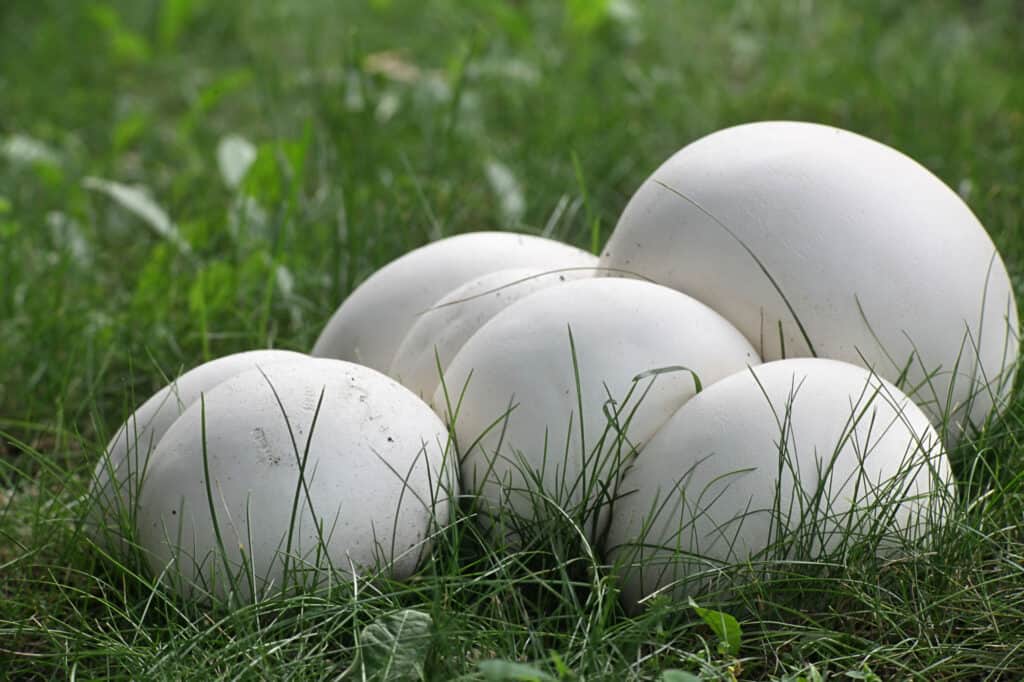
The
Calvatia giganteathrives on organic matter and can be used in food.
©Henri Koskinen/Shutterstock.com
7 Key Differences between Death Cap Mushrooms vs. Puffball Mushrooms
Discover seven key differences when comparing death cap mushrooms vs. puffball mushrooms.
1. Appearance and Physical Characteristics
When fully grown, the death cap mushrooms have a cap and a stem, but when young and in egg form they can look strikingly like a small puffball. When fully grown they have a convex or flat cap ranging from greenish-yellow to brown. The cap may have a metallic sheen with age or drying. They can vary in size from tiny buttons to large caps that measure up to 15 cm in diameter. The stem is white and has a ring (annulus) and a bulbous base (volva).
Puffball mushrooms don’t have a cap or stem but are solid spheres of fungus. They come in various sizes. Some species can grow as big as a soccer or beach ball. Others are no larger than a pea.
Puffballs come in different species, and their outer skin color can vary. Even their stage of development can affect their color. For instance, some puffballs start with a white or cream outer skin that gradually turns yellow as they mature. But that’s not all! As puffballs develop, their inner flesh transforms remarkably, changing from a dark green to a purple mass of spores.
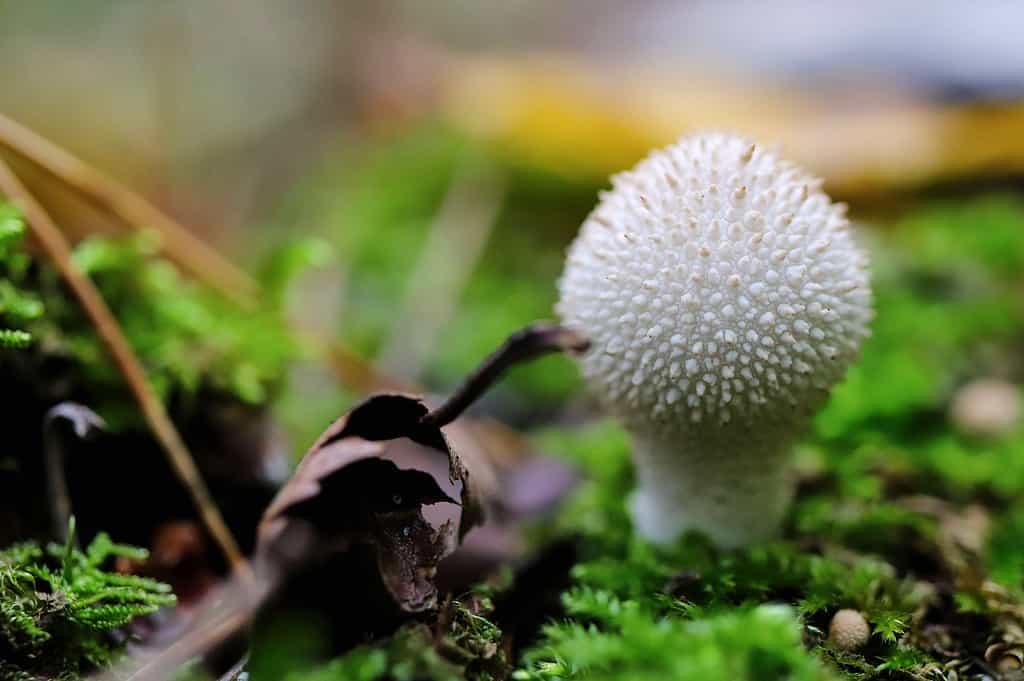
Puffball mushrooms don’t have a cap or stem but are solid spheres of fungus.
©iStock.com/sanches812
2. Gills and Spore Release
Gills, the delicate and thin structures resembling paper, can be found under the cap of certain types of mushrooms. These structures, also known as lamellae, serve a vital purpose in the production and distribution of spores. Depending on the species, the gills may be attached to the stem, free or even forked. Mushrooms come in varying colors, shapes, sizes, and stem attachments. Therefore, identifying them may rely on examining their unique gill characteristics.
Death cap mushrooms possess distinct white or cream-colored gills underneath their caps. These gills bear the mushroom’s spores essential for the reproduction and propagation of new individuals.
Conversely, puffball mushrooms lack gills and have a spherical fruit body called a gasterothecium, which internally produces spores. Upon disturbance, the fruit body releases these spores dispersed by wind to new locations, facilitating the germination and growth of new puffball mushrooms and plants.
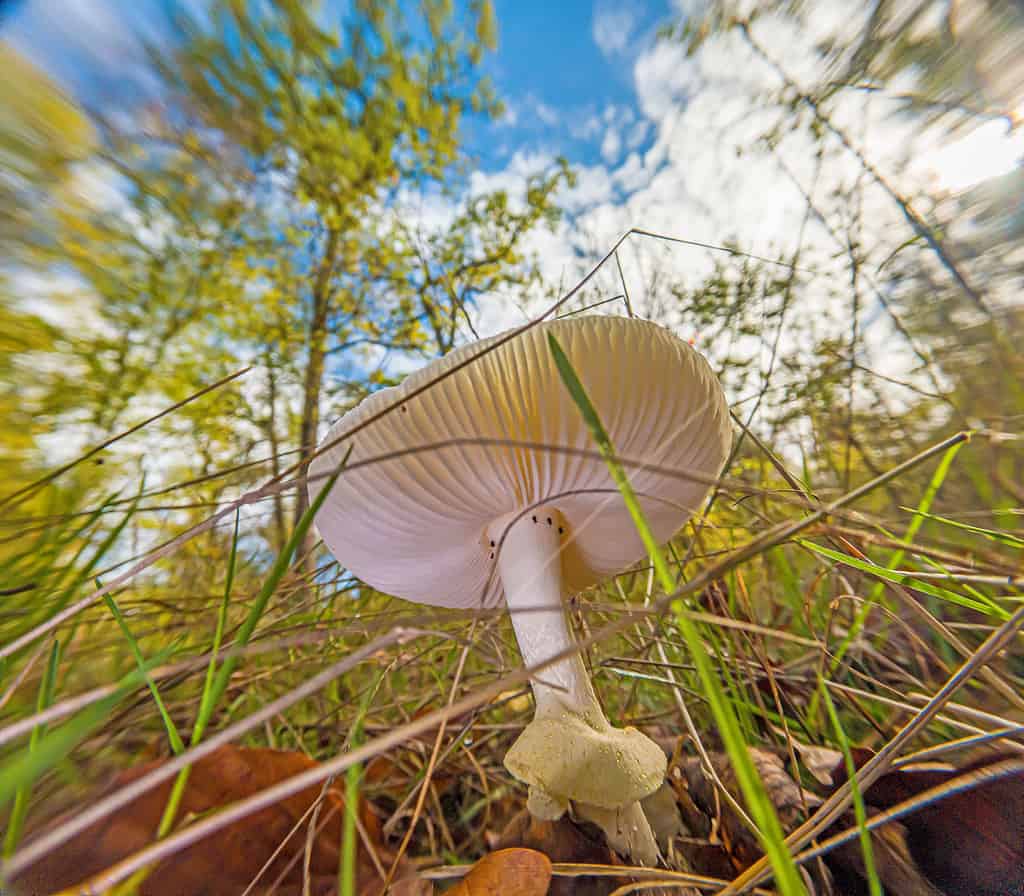
Death cap mushrooms possess distinct white or cream-colored gills underneath their caps.
©iStock.com/Pictures-and-Pixels
3. Poisonous or Edible
Death cap mushrooms are deadly poisonous. As said, they can cause severe poisoning and death in mammals such as dogs, cats, horses, cows, sheep, pigs, and humans. However, some animals, such as squirrels, rabbits, slugs, and insects, can eat them without ill effects. These animals have different metabolisms that can process and eliminate the toxins in death cap mushrooms.
Puffball mushrooms are edible when they’re young and fresh before they start producing spores. However, eating mature puffballs can be dangerous, as they release large amounts of spores that can cause a severe but rare lung disease called lycoperdonosis.
Lycoperdonosis is a type of hypersensitivity pneumonitis, an inflammation of the alveoli (the tiny air sacs) in the lungs caused by an allergic reaction to inhaled dust or particles. In the case of lycoperdonosis, the dust is the spores of mature puffballs, which can be accidentally inhaled when handling, cutting, or eating them. The spores can also be released into the air by wind or pressure. The symptoms of lycoperdonosis usually appear within hours or days after exposure to the spores and include:
- Cough
- Fever
- Shortness of breath
- Chest pain
- Muscle ache
- Fatigue
The best way to prevent lycoperdonosis is to avoid exposure to mature puffballs and their spores. This can be done by:
- Identifying and harvesting only young and white puffballs that are safe to eat
- Discarding any puffballs that show signs of maturity, such as browning, cracking, or opening
- Wearing a mask or respirator when handling or cutting puffballs
- Avoiding areas where puffballs grow or where spores may be present in the air

Puffball mushrooms are edible when they’re young and fresh before they start producing spores.
©iStock.com/Henrik_L
4. Ecological Role and Interactions with Other Organisms
Death cap mushrooms thrive on a mutually beneficial symbiotic relationship with tree roots. This fascinating relationship, called mycorrhizal, allows the mushroom and the tree to work together in harmony, each providing crucial resources that the other needs to thrive.
The mushroom’s mycelium forms the foundation of this relationship, creating a delicate network of tiny root-like threads that permeate the soil and interweave with the tree’s roots. These threads facilitate the exchange of crucial nutrients and water between the mycelium and tree roots.
Meanwhile, the tree reciprocates by giving the mushroom vital sugars generated through photosynthesis. In addition, mycelium plays a vital role in decomposing organic matter in the soil, generating additional nutrients that nourish the tree.
Puffball mushrooms are saprotrophs. They acquire nutrients by breaking down decaying organic matter. As an integral component of the ecosystem, these fungi assist in the decomposition of plant debris, which facilitates the recycling of crucial nutrients back into the soil. This process, in turn, promotes the growth and advancement of other plants and organisms in the ecosystem. However, certain species of puffball mushrooms engage in a symbiotic relationship with trees and plants.
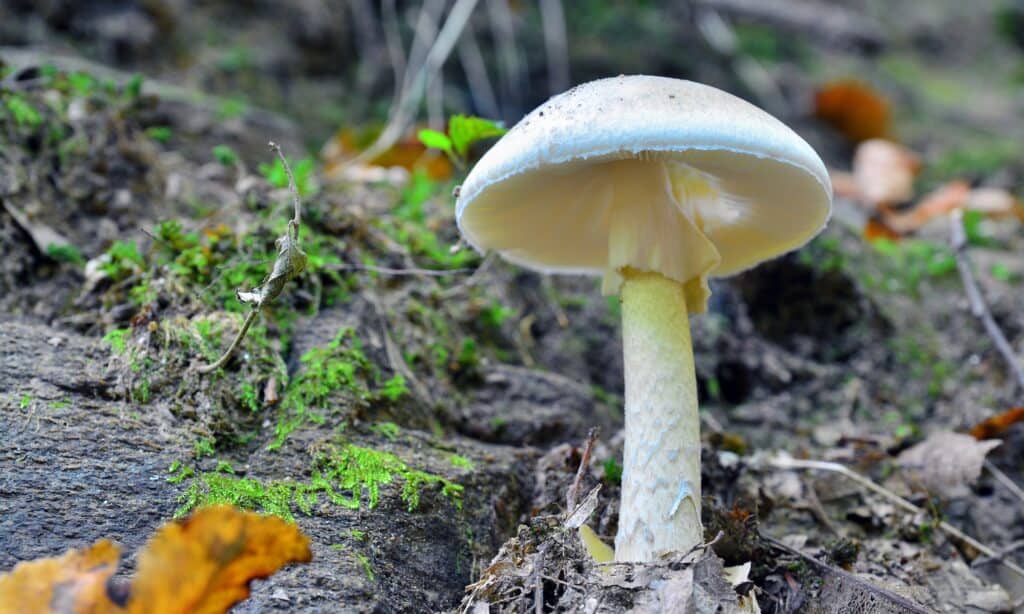
Death cap mushrooms thrive on a mutually beneficial symbiotic relationship with tree roots.
©iStock.com/empire331
5. Time of Year of Fruit Body Formation
The seasonal growth pattern of both death cap and puffball mushrooms is usually observed during the late summer and early fall months in temperate regions of the world. However, their appearance may vary depending on environmental factors such as weather conditions, soil moisture, temperature, and light availability.
Abundant rainfall and warm temperatures in a region may cause the fruiting bodies of these mushrooms to appear earlier in the season, sometimes as early as mid-summer. Conversely, in cooler and drier regions, the fruiting bodies may not appear until late fall, or they may not appear at all during particularly dry years.

Both death cap and puffball mushrooms typically exhibit a seasonal growth pattern that is commonly observed in late summer and early fall.
©iStock.com/Alexander Shein
6. Smell and Taste
Mushrooms can be differentiated by smell and taste, but this method should be used cautiously. While smell and taste can provide additional clues to identifying a mushroom, they should never be the sole determining factor in identifying a mushroom. Confirming other identifying features such as the cap and stem shape, color, gills, spores, and habitat is crucial to ensure the mushroom’s identity before smelling or tasting it.
In the case of death cap mushrooms, relying on smell and taste can be especially dangerous. These mushrooms are highly toxic, and no distinctive odor or flavor characteristics would warn people of their toxicity. Some who mistakenly ate death cap mushrooms have even described them as delicious.
Puffball mushrooms emit a mild or sweet aroma in their youthful stage and are edible, offering a mild or slightly nutty flavor when cooked. Nevertheless, their smell turns unpleasant as they mature, rendering them inedible.

No distinctive odors or flavors can warn people of death cap mushrooms’ toxicity.
©el_cigarrito/Shutterstock.com
7. Medicinal Properties and Health Benefits
Amino Acids
Giant puffballs are an excellent source of amino acids, the fundamental units that make up proteins. According to research, essential amino acids such as lysine, tryptophan, isoleucine, leucine, threonine, methionine, valine, histidine, and phenylalanine are present in giant puffballs. Your body relies on essential amino acids for vital biological processes but can’t synthesize them independently. Therefore, including amino acid-rich foods like giant puffballs in your diet is crucial.
Protein
Protein is vital for your body’s growth, maintenance, and repair. It also helps regulate your metabolism, hormones, enzymes, and immune system. Giant puffballs are rich in protein and low in calories. This makes them a great option for people who want to increase their protein intake without adding too many calories.
Fiber
Giant puffballs are also rich in fiber. Fiber is a carbohydrate that your body can’t digest or absorb. It helps regulate digestion, bowel movements, blood sugar, cholesterol, and appetite. Fiber also feeds the beneficial bacteria in the gut that support your immune system and overall health.
Wound Healing
The Lakota tribe of Native Americans found medicinal use for this mushroom as a powder. They used it to treat bleeding wounds and promote blood clotting. Injured persons applied giant puffball spores on open wounds to close them and prevent infection.
Antidiabetic Effects
According to a study published in WebMD, giant puffballs showed significant antidiabetic effects by decreasing alpha-amylase levels in the body. The researchers suggested that giant puffballs can be a functional food to maintain blood sugar levels and prevent diabetes. They also proposed that giant puffballs can be used to develop medicines to manage the disease.
However, more research is needed to confirm the safety and efficacy of puffball mushrooms for diabetes management. Therefore, people with diabetes should consult their doctor before using puffball mushrooms or other natural remedies.
Anticancer
The death cap mushroom produces a toxin called amanitin that can kill cancer cells. Researchers have synthesized amanitin and are developing it as a potential cancer drug. In the 1960s, researchers isolated a substance called calvacin from giant puffballs (Calvatia gigantea). Calvacin was shown to inhibit sarcoma in lab mice. Sarcoma is a type of cancer that affects connective tissues, such as bones, muscles, and blood vessels.

Giant puffballs are rich in protein and low in calories.
©iStock.com/geoleo
Final Thoughts on Death Cap Mushroom vs. Puffball Mushrooms
It’s crucial to distinguish between deadly death cap mushrooms vs. puffball mushrooms (edible varieties). While the former poses a significant risk to one’s health, the latter can enhance one’s culinary experience. Therefore, it’s highly advised to seek the guidance of a proficient expert beforehand to avoid inadvertently consuming a poisonous mushroom. This straightforward safety measure can minimize any possible confusion and, more crucially, ensure your safety.
The photo featured at the top of this post is © Tomasz Czadowski/Shutterstock.com
The information presented on or through the Website is made available solely for general informational purposes. We do not warrant the accuracy, completeness, or usefulness of this information. Any reliance you place on such information is strictly at your own risk. We disclaim all liability and responsibility arising from any reliance placed on such materials by you or any other visitor to the Website, or by anyone who may be informed of any of its contents. None of the statements or claims on the Website should be taken as medical advice, health advice, or as confirmation that a plant, fungus, or other item is safe for consumption or will provide any health benefits. Anyone considering the health benefits of particular plant, fungus, or other item should first consult with a doctor or other medical professional. The statements made within this Website have not been evaluated by the Food and Drug Administration. These statements are not intended to diagnose, treat, cure or prevent any disease.
Thank you for reading! Have some feedback for us? Contact the AZ Animals editorial team.






